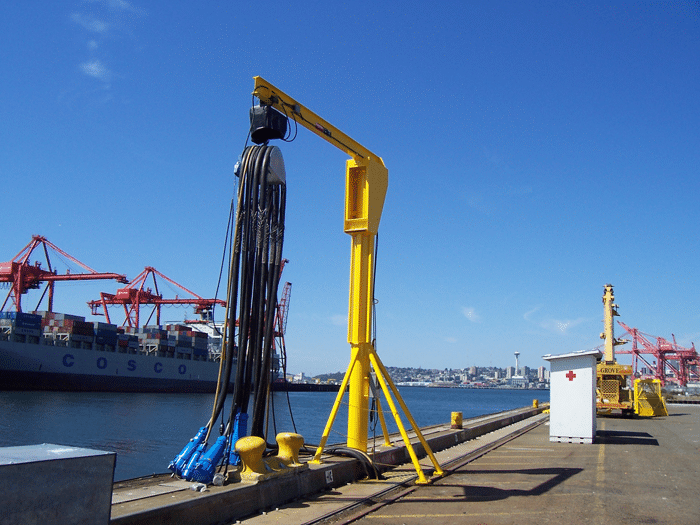Vessel Shore Power
Every year ships bring in millions of containers loaded with goods to U.S. ports. While these ports—which can vary significantly in size—serve as a gateway for international commerce, air pollution associated with port activities (e.g., from drayage trucks, tugboats, cranes, ocean-going vessel) garners less attention. Port-related operations emit toxins and other harmful emissions that pose a health risk to nearby communities. Particulate matter released from diesel engines can worsen asthma, decrease lung function, cause heart attacks and cancer, and result in premature death. Certain populations can be especially vulnerable to these pollutants, such as the elderly, children, and those with pre-existing health problems. Air pollution from ports also disproportionately impacts low income and minority populations.
U.S. ports today are growing significantly, due to the expansion of the Panama Canal and increased trade with Asia and other regions of the world. The amount of cargo processed in many ports throughout the United States is rising steadily. The Port of Savannah, for instance, handled 2.8 million TEUs (20-foot equivalent container units) in 2010. That number has increased rapidly to 4.35 million TEUs moved through the port in 2018.

However, the high levels of harmful emissions that accompany this significant growth at ports are often not properly accounted for or mitigated. Port growth without an emphasis on substantially reducing overall air pollution emissions from port-connected activities is unsustainable and irresponsible. Fortunately, there are some examples of positive efforts at several West Coast ports upon which to draw. For example, initiatives in the Puget Sound region have reduced diesel particulate matter by 72 percent and nitrogen oxides by 23 percent between 2005 and 2016. At the Port of Oakland, diesel particulate matter has fallen 81 percent since 2005. Furthermore, the Ports of Long Beach and Los Angeles have reduced diesel particulate matter by 88 percent and 72 percent, respectively, since 2005. The California ports mentioned are also embracing goals to become zero emissions seaports in the future.
While there is still more work to be done—which will be accomplished, in part, through new regulatory efforts by the California Air Resources Board—the trajectory of progress in reducing diesel emission levels on the West Coast is noteworthy. Conversely, in other areas of the country, ports often do not have adequate baselines (emission inventories) upon which to inform decision-making about environmental policies and practices. And even if they do, the information is not posted on their websites or made easily available to the public. They may also fail to dedicate staff to work on environmental or sustainability matters. Further, and importantly, many ports have no tangible plans (or even processes for developing plans) to cut air pollution emission levels from port-related activities.
Half measures by ports to deal with their environmental footprint are insufficient. This is particularly the case in urban environments where residents are exposed to multiple pollution sources (e.g., refineries, factories, power plants) in addition to the port.

There are, in fact, many proven ways to reduce emissions from ports. Namely, having ships use electrical grid power while docked (i.e., shore power) instead of running their diesel-powered auxiliary engines can decrease overall emissions substantially and nearly eliminate them at berth. A recent U.S. Environmental Protection Agency (EPA) report found that, for certain types of frequently calling ships, shore power on a per-call basis would reduce nitrogen oxide emissions by 62.1 to 89.9 percent and fine particulates (PM2.5 emissions) by 62.0 to 89.4 percent. Use of shore power at the Brooklyn Cruise Terminal is expected to result in overall monetized health benefits of nearly $9 million annually. Shore power can also reduce carbon dioxide emissions from ships at berth to varying degrees, and therefore provide a climate benefit too. At Savannah’s Garden City Terminals, shore power for containerships would reduce carbon dioxide emissions by 32 percent, or almost 12,000 metric tons per year.
Other methods are readily available to reduce port emissions from other operations. These include clean truck programs—which have been undertaken at the Ports of Seattle, Oakland, Los Angeles, and Long Beach—vessel speed reduction programs, harborcraft repowering efforts, and electrification of cargo handling equipment.
The U.S. EPA has assembled resources for seaports and other stakeholders to reduce emissions. The time to make progress on air quality issues and better safeguard public health in and around ports is now. We know the risks (and have for some time), we know what needs to be done; it is now a matter of doing it. Near-port residents deserve as much. The convenience of trade and cheap goods should not be predicated on sacrificing or impairing the health of those living adjacent to the ports. We can have economic activity at our ports while protecting human health and the environment.
